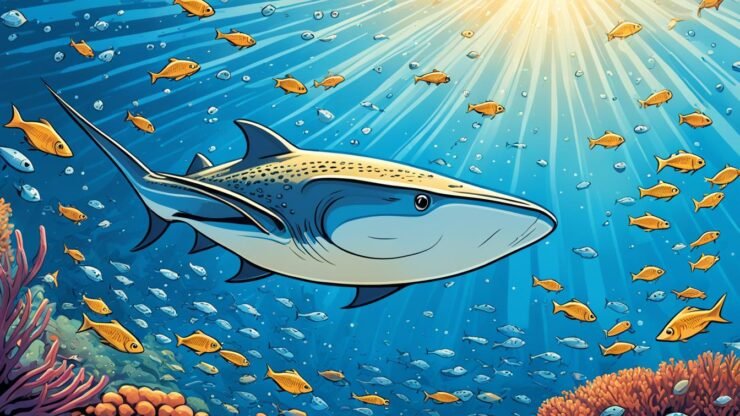In the Sinama Sea, the waves tell a story. It’s about the Sama Stingray, loved by the people in the Philippines. This creature is key to the Sama Dilaut’s life, showing their strong link to the sea.
The Sama Dilaut rely on the sea for everything. Their special connection with the Sama Stingray reflects this bond. It invites us to learn about their unique culture, their struggles, and how they make the sea their home.
Key Takeaways
- The Sama Stingray is a majestic creature deeply revered by the indigenous maritime communities in the Philippines.
- The Sama Dilaut’s (also known as the Sama or Bajau) seabound lifeways challenge the dominant terrestrial and territorial modes of thinking.
- The Sama Dilaut’s indigeneity and their plight as a marginalized community are explored in the article.
- The concept of an “aqueous mode of knowing” is central to the Sama Dilaut’s worldview and way of life.
- The article delves into the Sama Dilaut’s unique relationship with the sea and their reverence for the Sama Stingray.
Introduction
The bond between indigenous groups and their land is key to their identity. Sama Dilaut people in the Philippines face a unique issue. They live at sea, making it hard to claim land rights. The idea of “aqueous mode of knowing” highlights the importance of the sea in their culture and thinking, unlike most groups who focus on the land.
Indigeneity and Territorial Rights
The Sama Dilaut, also called Sama or Bajau, are native to the Philippines but live nomadically at sea. This makes it tough for them to assert their rights, which usually depend on living on land. They struggle to fit into the typical ideas of being indigenous due to their ocean-based lives.
The Plight of the Sama Dilaut
The Sama Dilaut number around 1.3 million globally, with big communities in Philippines, Malaysia, Indonesia, and Brunei. Even with their large numbers, they are often left out and find it hard to claim their indigenous rights. Their unique way of life at sea is a big reason for this.
Aqueous Mode of Knowing
This piece introduces the idea of “aqueous mode of knowing.” It shows how the sea influences everything about the Sama Dilaut, from their way of life to their thoughts. This way of thinking gives a fresh view on the Sama Dilaut’s connection with their environment and their fight for territorial rights.
Navigating the Sinama Sea
The Sama Dilaut people have a deep bond with the Sinama Sea. They use special ways to travel and find their way in the sea. Their traditions and practices help them understand and thrive in their watery world.
Traversing the Seascape
The Sama Dilaut are always moving through the Sinama Sea, showing their amazing skill at sea navigation. They know how to use the sea’s currents and watch for small changes. This lets them travel smoothly and adjust to the sea’s many faces.
Tropography and Philology
Understanding tropography is key for the Sama Dilaut to navigate the Sinama Sea. This is about studying tropes and how they fit in the world. They use the deeper meanings of their language and culture to guide their way. These clues help them find their path through the vast sea.
Sama Dilaut Orature
The Sama Dilaut have a treasure of orature, which are the stories and poems they pass down. Their orature shows their strong tie to the sea. They talk about the sea’s beauty and its moods in their songs and tales. These stories are like a map, leading them through their adventures on the Sinama Sea.
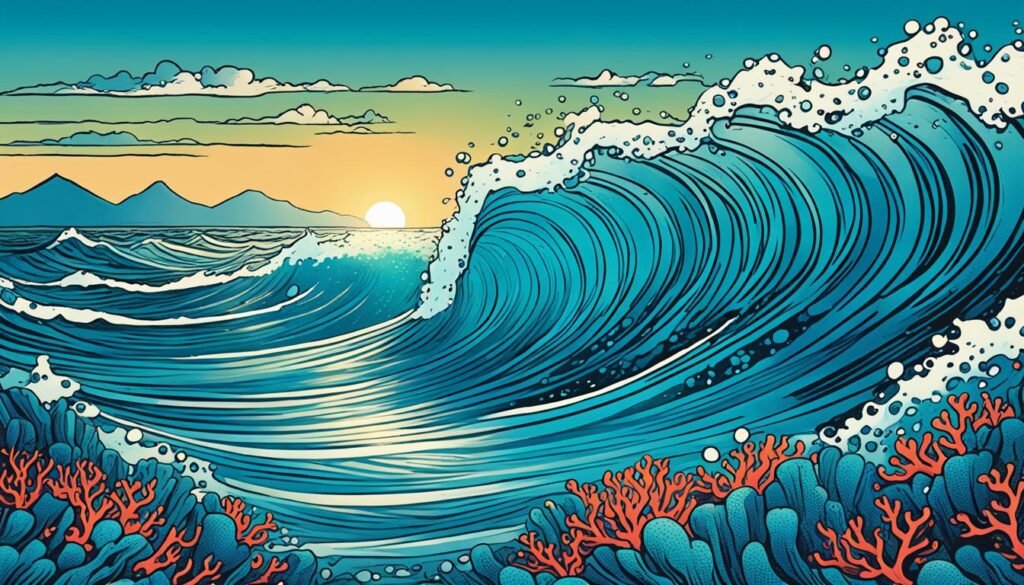
Sama Stingray: A Revered Creature
The Sama Dilaut people of the Philippines think highly of the Sama Stingray. They see it as a key part of their maritime mythology. It highlights their deep respect for the sea and its creatures.
The Sama Stingray means more to the Sama Dilaut than just a sea animal. It represents their unique way of life focused on the ocean. This connection challenges common ways of understanding the world.
The Sama Dilaut share stories to honor the Sama Stingray in their culture. These tales show why the community respects the creature. They also show the people’s deep knowledge of the sea.
The Sama Stingray stands for the Sama Dilaut’s strong tie with the sea. It shows their commitment to keeping their ocean home healthy. This relationship proves the people’s strength and their harmonious bond with the ocean.
| Characteristics of the Sama Stingray | Significance in Sama Dilaut Culture |
|---|---|
| Large size and graceful movements | Symbolizes the vastness and power of the sea, which the Sama Dilaut navigate with skill and reverence |
| Nocturnal nature | Represents the mysteries and hidden depths of the marine world, which the Sama Dilaut seek to understand through their aqueous mode of knowing |
| Rare sightings | Imbues the Sama Stingray with an aura of sacredness and mysticism, further strengthening the Sama Dilaut’s indigenous reverence for the creature |
The Sama Stingray plays a central role in the Sama Dilaut’s beliefs and life. It showcases their deep love for the sea. This honor for the Sama Stingray shows their dedication to the ocean, their true home.
The Fluidity of Dwelling
The Sama Dilaut live at sea in a way that’s different from Western ideas. They challenge what we think about dwelling, which usually means living on land. This group, the Sama-Bajau, move a lot and don’t follow the typical rules of staying in one place or owning land.
Terrestriality and Territoriality
The Sama Dilaut have lived across the seas of the Philippines, Malaysia, and Indonesia for a long time. They don’t see dwelling the way many others do. Instead of a fixed place, they find their sense of home in the ever-changing sea.
Inhabitancy Without Territoriality
The Sama Dilaut show us a unique way of living – one without needing a fixed piece of land. This way of life goes against the Western idea that places like these need defined borders. For them, moving and changing with their environment is natural, showing that home can be wherever they are.
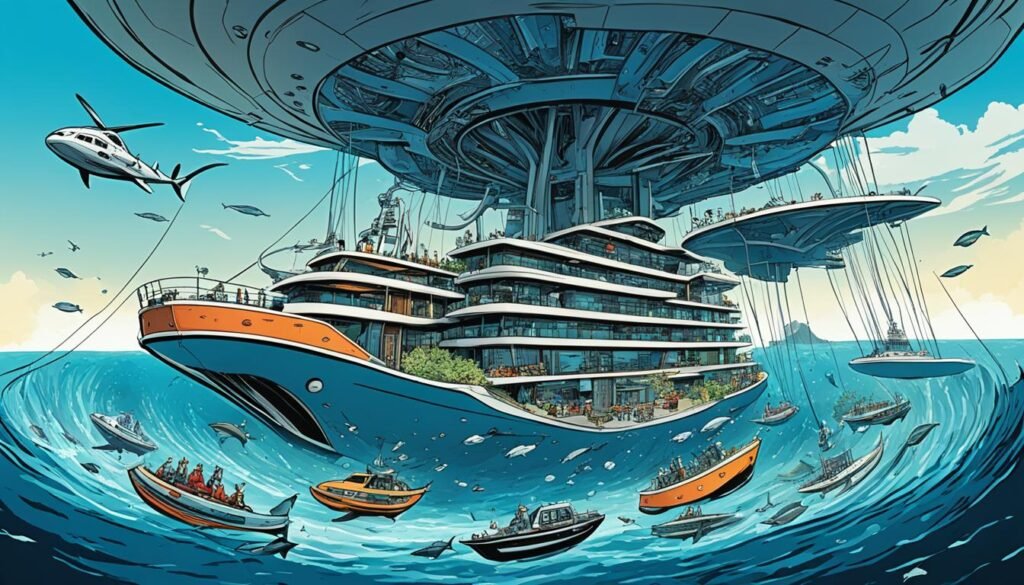
Panduga: Reference Points
The Sama Dilaut people find “panduga,” or reference points, very important as they journey across the sea. They don’t focus on owning pieces of the ocean like some do on land. Instead, they keep changing where they call home in the sea. This flexible way of thinking contrasts with Western ideas. Westerners often see the sea as endless, with no place for real connections or freedom.
Tropes and Tropography
The Sama Dilaut’s way of navigating the seas is based on knowing about tropes and tropography. Tropes mean specific things to them, and they understand the space around these things. This knowledge shapes how they see and move through the water. By using panduga as markers, they can travel their sea, the Sinama Sea, in a way that breaks from land-based thinking.
The Sama Dilaut’s panduga aren’t set points on a map, but flexible guides that change along with the sea. Their way of navigating highlights a different view on space and movement. This method shows how indigenous sea people see and use their surroundings in a new light.
By knowing the sea as their main space, the Sama Dilaut have a whole different outlook. They see the ocean as always changing, just like their way of understanding it. This view leads them to develop a special way of finding their path across the sea. They move skillfully because they see the sea as their friend, always ready to change but also help them along their way.
Navigating Through Impermanence
The Sama Dilaut are the indigenous, sea-going people of the Philippines. They are famous for their lives at sea in the Sinama Sea. Their lives are always moving, they settle along the coastlines where land meets the sea.
The Sama people are not like others who stay in one place. They live in houses on stilts or on floating rafts. These homes show how they adapt to the sea’s changes. Moving and settling often is natural for them, showing their deep understanding of life’s constant change.
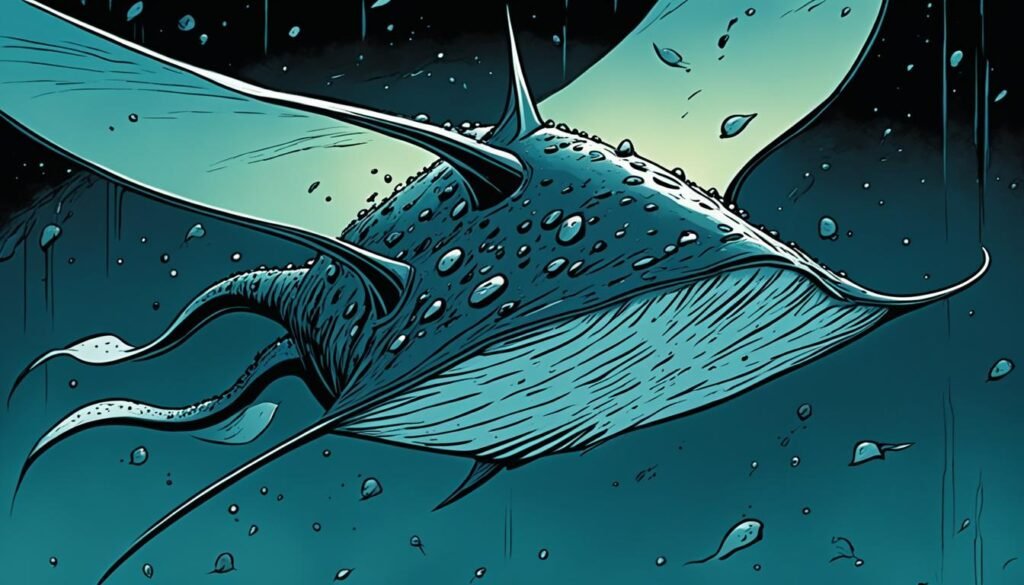
The Sama Dilaut have a special way of finding their way at sea. They use “panduga,” a system of points in the sea to guide them. These points change as they move, helping them stay oriented in the vast waters.
The Sama Dilaut’s way of life challenges what many think is normal. They have a different view of staying in one place and owning land. Their life on the sea shows a beautiful relationship between people and nature. They understand that change is part of life, and they know how to live through it.
Challenging the Terrestrial Dominance
The Sama Dilaut community lives mainly on the sea. This unique lifeway challenges the usual way we think about space and place. They move across the seas, not bound by national borders, changing how we see homes and the sea.
Living on the edges of land without owning it, the Sama Dilaut offer a different view. They know the sea deeply, showing a different way of understanding the world.
In Southeast Asia, where they live, the Sama Dilaut’s way of life doesn’t fit with the region’s countries’ ideas of owning the sea. Their ongoing movement and not having permanent homes shake up the usual thinking that land alone is important.
The Western idea of the sea being a “non-place” has made it hard to see the sea as a meaningful space. But the Sama Dilaut show how the sea is actually very important, both symbolically and in real life, in Southeast Asian culture.
By living mainly on the sea, the Sama Dilaut change how we see homes and the sea. Their lifestyle directly criticizes the common view that land is the most important. Instead, they highlight the sea’s importance by always moving through it.
The Archipelagic Geography
The Sama Dilaut people live in the Philippines’ ocean communities. They deeply know the archipelagic geography, which influences their lives. Their view isn’t land-focused like most. They see a dynamic bond between the seas and islands around them.
Delineating Seas and Islands
For the Sama Dilaut, archipelagic geography is more than landmasses and water. It’s a lively seascape full of connections. They expertly move through the Sulu and Celebes Seas, showing their deep knowledge. This understanding lets them easily travel and fish in these waters.
The Sama Dilaut also see islands in a unique way. They view islands as changing, not fixed, parts of their world. Because of their sea-based lives, islands are where they briefly rest or plan their next moves.
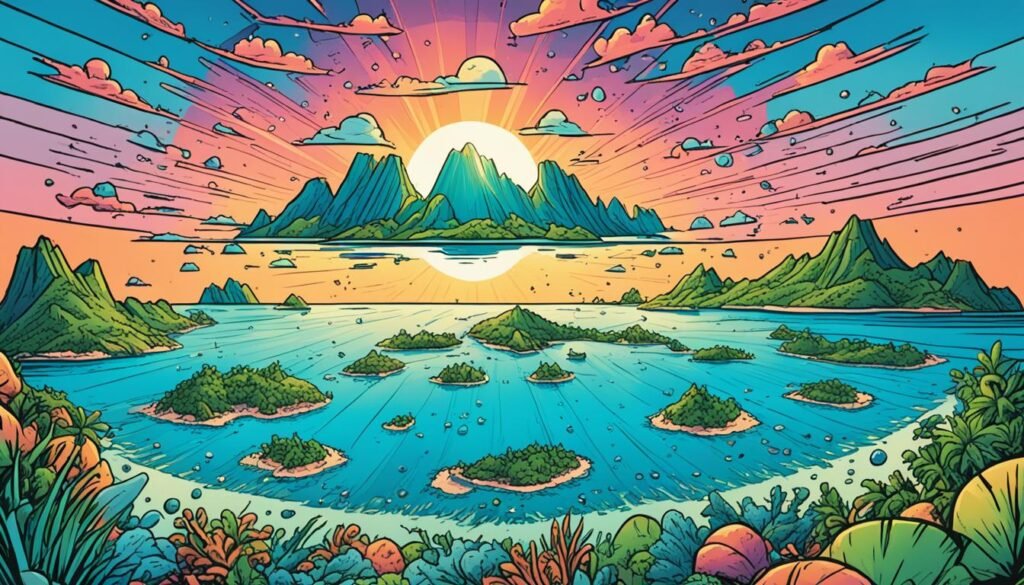
| Region | Sama-Bajau Population |
|---|---|
| Philippines | ~499,620 |
| Malaysia | ~436,672 |
| Indonesia | ~345,000 |
| Brunei | ~12,000 |
The Sama Dilaut shine a different light on archipelagic geography. They focus on the sea, not just the land and islands. Their detailed knowledge and deep connection show us another way to understand the area. It teaches us to value diverse human experiences and ways we interact with our planet.
Aquatic Vision of Orature
The Sama Dilaut people deeply connect with the sea. Their stories and songs, like “Lumujum Sahaya,” show this bond. Their rich tradition, called orature, is full of tales linking them to the sea and its edge. This shows how their lives blend with the sea’s waters.
Emerging from the Sea
The Sama Dilaut have a unique view because they focus on the sea. They see themselves as beings who came from the sea. For them, the sea isn’t just a background. It’s part of who they are. This idea shapes their way of looking at the world.
Merging Land and Sea
The Sama Dilaut’s stories mix the land and sea well, not seeing them as separate. Their orature talks about moving between both worlds. It shows how easily they fit in on land and in water. This challenges the idea that we must choose one place to belong.
Reinterpreting the Archipelago
The Sama Dilaut people see things differently. They focus on the sea more than the land. This is because they live on boats and travel across the seas. So, to them, the connection with the seas is key.
Focusing on the Sea
The Sama Dilaut’s life is deeply tied to the sea. They are masters at sailing its waters. Instead of thinking about the land, they see the archipelago as linked by the seas. Their understanding is based on the sea more than the land.
Choosing the sea changes everything. It questions our usual thoughts on where people live. The Sama Dilaut show us a different way. They highlight the sea’s importance for living, traveling, and creating culture in these areas.
Sama Dilaut Lifeways
The Sama Dilaut, described as sea-nomads or boat-people, have lived in the Sulu and Celebes seas for ages. They are closely linked to the rhythms and resources of the littoral zones. Because they constantly move, it’s hard to say which sea areas belong to them. However, their seascape navigation skills help them prosper in the archipelago’s dynamic settings.
For the Sama Dilaut groups, the sea is like a home. They deeply respect it. You can see this in how they adapt to the littoral zones. For example, some families at Matina Aplaya still depend on the sea, even though there are fewer fish now.
Territorialization of the sea and country borders now bring problems. They push people like the Sama Dilaut out of their homes. This makes some of them start begging in cities to live.
But the Sama Dilaut keep moving through the littoral zones. They use their deep knowledge of the seascape in their daily life. Their strength and change-adapting skills show their strong spirit. This native maritime community’s link to the sea is key to their culture and way of life.
Conclusion
The story of the Sama Dilaut, a bold maritime community in the Philippines, shows us the deep bond between them and the sea. It highlights their respect for the Sama Stingray. It shows how their cultural identity is closely connected to the ocean.
The Sama Dilaut teach us about moving homes and rethinking lands. Their life at sea reshapes our view on living with nature. Their stories and literature share an amazing way of looking at the world around us.
The Sama-Bajau people’s numbers are growing, reaching about 1.3 million worldwide. They are mainly found in the Philippines, Malaysia, Indonesia, and Brunei. We should value their unique view of the sea and the knowledge they bring. It can help us better respect and learn from how different communities live with the ocean.
FAQ
What is the significance of the Sama Stingray for the indigenous maritime communities in the Philippines?
How do the Sama Dilaut challenge the dominant notions of territoriality and terrestriality?
What is the “aqueous mode of knowing” that informs the Sama Dilaut’s worldview and way of life?
How do the Sama Dilaut’s orature (oral traditions and literature) depict their “aquatic vision”?
How do the Sama Dilaut navigate their seascape, the Sinama Sea?
Source Links
- https://www.science.gov/topicpages/p/peru south america
- https://en.wikipedia.org/wiki/Sama-Bajau
- https://thecordillerareview.upb.edu.ph/wp-content/uploads/2021/06/4-TCR-VIII-1-Karaan.pdf
- https://pure.roehampton.ac.uk/portal/files/1061205/Midamble_final_proof_Janaury_2018_copy.pdf
- https://www.academia.edu/56937637/Environmental_Alterities
- https://en.wikipedia.org/wiki/Sabah
- https://ro.uow.edu.au/cgi/viewcontent.cgi?referer=&httpsredir=1&article=1257&context=kunapipi
- https://www.aswangproject.com/why-is-salt-a-deterrent-against-engkantos-and-folkloric-spirits/
- https://theaquaticape.org/tag/sama-dilaut/

